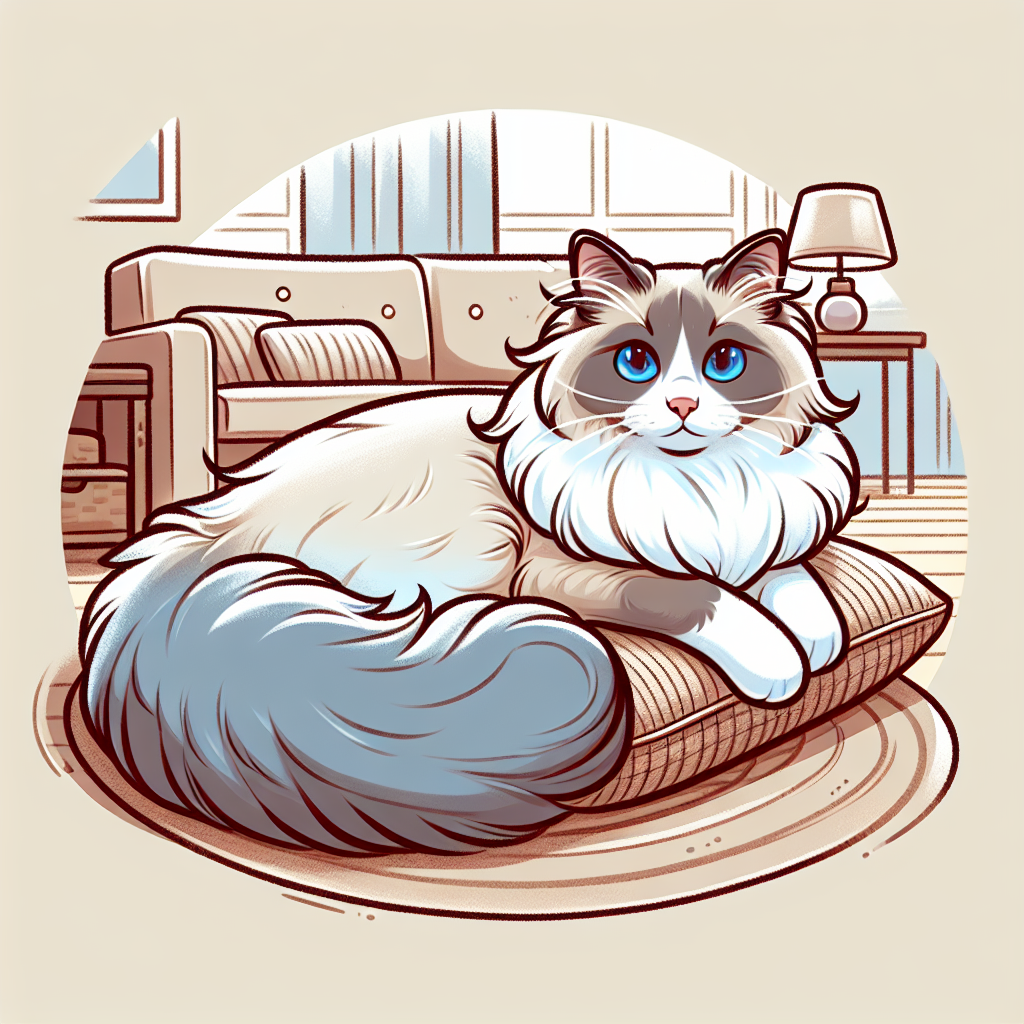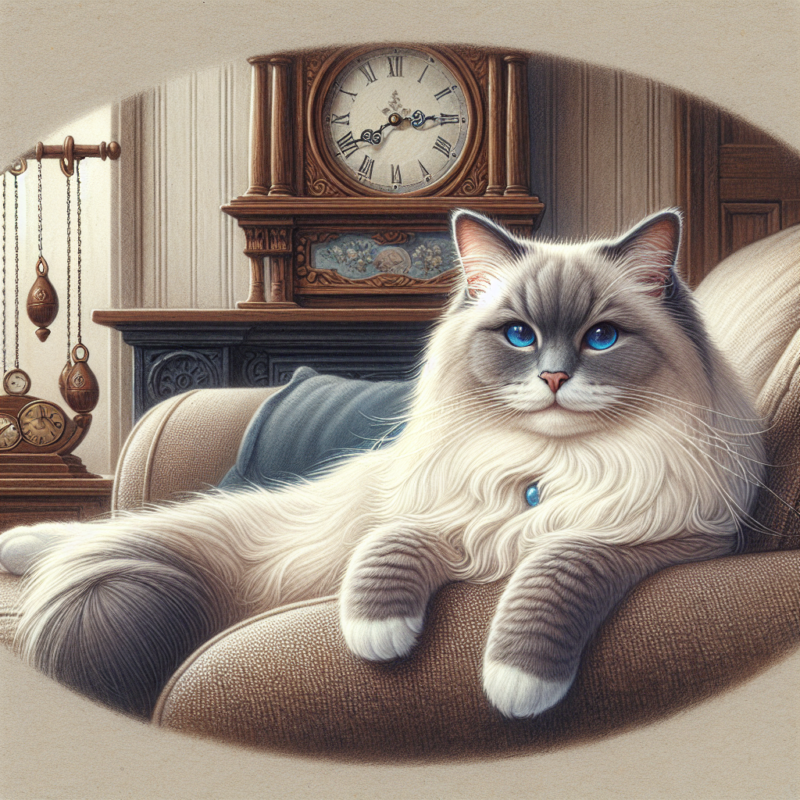About Ragdoll kittens
Is Ragdoll a lazy cat?
Is Ragdoll a lazy cat?
The Truth About Ragdoll Cats: Debunking the Myth of Laziness
Ragdoll cats are often described as being lazy and laid-back, with a tendency to flop and go limp in their owner’s arms. This stereotype has been perpetuated by popular media and even some breeders, leading many to believe that Ragdolls are not as active or playful as other cat breeds. However, this couldn’t be further from the truth. In this article, we will debunk the myth of Ragdoll cats being lazy and explore the truth behind their calm demeanor.
First and foremost, it’s important to understand that every cat, regardless of breed, has its own unique personality and energy level. While some Ragdolls may indeed be more laid-back than others, this does not mean that the entire breed is lazy. Ragdolls are known for their gentle and affectionate nature, making them great companions for families and individuals alike.
One of the reasons why Ragdolls may appear to be lazy is because they are not as active as some other breeds. This is due to their large size and heavy build, which can make them less agile and prone to lounging around. However, this does not mean that they are not playful or energetic. Ragdolls are known to have bursts of energy and enjoy playing with toys and interacting with their owners. They may not be as hyperactive as some breeds, but they are certainly not lazy.
Another factor that contributes to the misconception of Ragdolls being lazy is their tendency to go limp when picked up or held. This behavior, known as “ragdolling,” is an instinct in the breed and is a result of their relaxed and trusting nature. It is not a sign of laziness, but rather a display of their gentle and docile personality. Ragdolls are known for their love of being held and cuddled, and their tendency to go limp only adds to their charm.
Furthermore, Ragdolls are not a sedentary breed. They may not be as active as some other breeds, but they still require regular exercise and playtime to maintain their physical and mental well-being. Owners need to provide their Ragdoll with toys and activities that stimulate their minds and keep them physically active. This can include puzzle toys, interactive play sessions, and even leash training for outdoor walks.
It’s also worth noting that Ragdolls are not lazy when it comes to grooming. Their long, silky coat requires regular brushing to prevent matting and keep it looking healthy. While they may not be as high-maintenance as some other long-haired breeds, they still require a certain level of grooming to keep their coat in top condition. This is something that potential owners should consider before bringing a Ragdoll into their home.
In addition to their playful and affectionate nature, Ragdolls are also known for their intelligence. They are quick learners and can be trained to do tricks and respond to commands. This goes against the stereotype of lazy cats who are not as intelligent as their more active counterparts. Ragdolls are highly adaptable and can thrive in various environments, making them a great choice for first-time cat owners.
In conclusion, the myth of Ragdoll cats being lazy is just that – a myth. While they may not be as active as some other breeds, they are by no means lazy. Their calm and gentle demeanor, coupled with their love for cuddles and playtime, make them a wonderful addition to any household. It’s important to remember that every cat, regardless of breed, has its own unique personality and energy level. So, the next time someone tells you that Ragdolls are lazy, you can confidently debunk this myth and share the truth about these lovable and affectionate felines.
5 Reasons Why Ragdoll Cats May Appear Lazy

Ragdoll cats are known for their docile and laid-back nature, often earning them the reputation of being lazy. However, this is a common misconception about this breed. While they may appear to be lazy at times, there are several reasons why Ragdoll cats may exhibit this behavior. In this article, we will explore five reasons why Ragdoll cats may appear lazy.
1. They are a slow-maturing breed
One of the main reasons why Ragdoll cats may seem lazy is because they are a slow-maturing breed. Unlike other cat breeds that reach their full size and maturity within the first year, Ragdolls take up to four years to fully mature. This means that they may have a slower pace and may not be as active as other breeds during their first few years of life. As they grow older, they become more active and playful, shedding their lazy image.
2. They are indoor cats
Ragdoll cats are primarily indoor cats, and this can contribute to their perceived laziness. Unlike outdoor cats who have more space to roam and explore, Ragdolls are confined to the indoors. This limited space may lead to a sedentary lifestyle, making them appear lazy. However, it is essential to note that Ragdolls are not entirely inactive. They still require regular playtime and exercise to maintain their physical and mental well-being.
3. They have a calm and gentle nature
Ragdoll cats are known for their calm and gentle nature, making them the perfect lap cats. They are not as hyperactive as other breeds and prefer to spend their time lounging and relaxing. This laid-back personality can give off the impression that they are lazy. However, it is essential to understand that this is just their natural temperament, and they are not lazy by nature.
4. They are sensitive to changes in their environment
Ragdoll cats are highly sensitive to changes in their environment, and this can affect their activity levels. Any changes in their routine or surroundings can cause them to become anxious and withdrawn, leading to a decrease in their activity levels. This may give off the appearance of laziness, but it is simply a reaction to their sensitive nature. Ragdoll owners must maintain a stable and consistent environment for their cats to thrive.
5. They are prone to obesity
Another reason why Ragdoll cats may appear lazy is because they are prone to obesity. Due to their laid-back nature and love for food, Ragdolls can easily become overweight if not given a balanced diet and regular exercise. Obesity can lead to a decrease in their activity levels, making them appear lazy. Ragdoll owners need to monitor their cat’s diet and ensure they are getting enough exercise to prevent obesity.
In conclusion, Ragdoll cats are not lazy by nature. Their slow-maturing breed, indoor lifestyle, calm temperament, sensitivity to changes, and susceptibility to obesity can all contribute to their perceived laziness. Ragdoll owners must understand their cat’s needs and provide them with a stable and stimulating environment to keep them happy and healthy. With proper care and attention, Ragdolls can be just as active and playful as any other cat breed. So, the next time you see a Ragdoll lounging around, remember that they are just taking a well-deserved break from their slow-paced lifestyle.
How to Keep Your Ragdoll Cat Active and Engaged: Tips for Preventing Laziness
Ragdoll cats are known for their laid-back and docile nature, often earning them the reputation of being lazy. However, this is a common misconception as Ragdolls are quite active and playful cats. As a responsible owner, it is important to keep your Ragdoll cat active and engaged to prevent them from becoming lazy. In this article, we will discuss some tips on how to keep your Ragdoll cat active and prevent laziness.
First and foremost, it is important to understand that Ragdoll cats are not inherently lazy. They are a breed that loves to play and interact with their owners. However, they do have a tendency to become too comfortable and relaxed, which can lead to laziness. This is why it is crucial to provide them with opportunities for physical and mental stimulation.
One of the best ways to keep your Ragdoll cat active is through interactive play. This can include playing with toys such as feather wands, laser pointers, and puzzle toys. These toys not only provide physical exercise but also stimulate their natural hunting instincts. It is important to rotate their toys regularly to keep them interested and engaged.
Another great way to keep your Ragdoll cat active is by providing them with a scratching post or a cat tree. These not only serve as a place for them to scratch and stretch but also as a form of exercise as they climb and jump on them. It is important to choose a sturdy and tall scratching post or cat tree to accommodate their large size.
In addition to physical exercise, mental stimulation is also crucial for preventing laziness in Ragdoll cats. These intelligent cats need mental stimulation to keep their minds sharp and active. One way to provide this is through training. Yes, you read that right – Ragdoll cats can be trained! They are highly trainable and can learn tricks and commands just like dogs. This not only keeps them mentally stimulated but also strengthens the bond between you and your cat.
Another way to provide mental stimulation is through food puzzles. These are toys that require your cat to work for their food, stimulating their problem-solving skills. You can also hide treats around the house for them to find, keeping them entertained and active.
Aside from play and mental stimulation, it is also important to provide your Ragdoll cat with a stimulating environment. This can include having perches near windows for them to watch birds and other outdoor activities, as well as having a variety of toys and scratching posts around the house. You can also consider getting a companion for your Ragdoll cat, as they are social animals and enjoy the company of other cats.
It is also important to note that Ragdoll cats are prone to obesity, which can lead to laziness. Therefore, it is crucial to monitor their diet and provide them with a balanced and appropriate amount of food. Consult with your veterinarian to determine the right diet for your Ragdoll cat based on their age, weight, and activity level.
In conclusion, Ragdoll cats are not lazy by nature, but they do tend to become too comfortable and relaxed. As responsible owners, we must provide them with opportunities for physical and mental stimulation to prevent laziness. Through interactive play, mental stimulation, a stimulating environment, and a balanced diet, you can keep your Ragdoll cat active and engaged, leading to a happy and healthy feline companion.


Pingback: What are the pros and cons of owning a Ragdoll cat? - Kitten Breeders